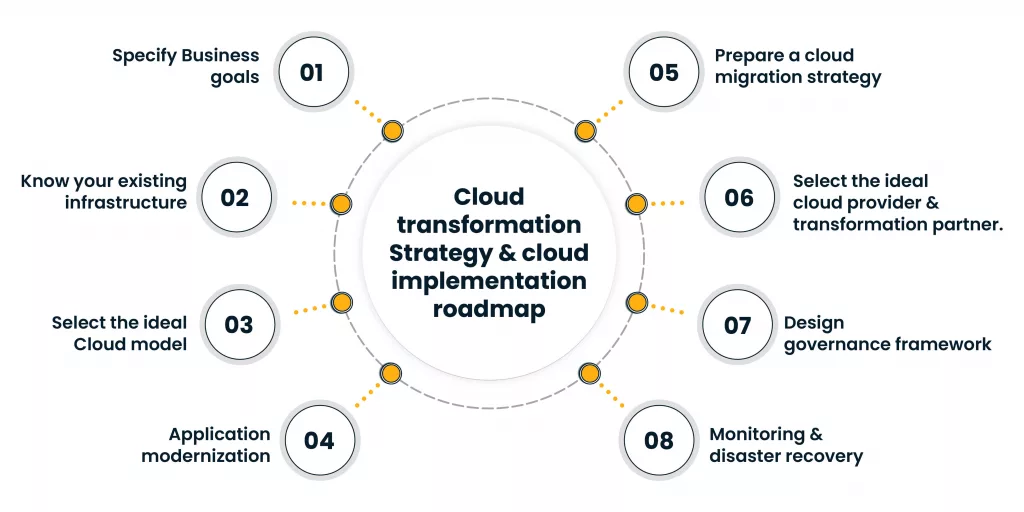Cloud transformation is no longer a dream; it is present, and various brands like Apple, eBay, etc., have moved to clouds as they understand the need for cloud for expansion and global reach of their business market.
According to a recent forecast by MarketsandMarkets, the global cloud computing market is expected to grow from approximately US$ 1.29 trillion in 2025 to US$ 2.28 trillion by 2030, a compound annual growth rate of around 12%.
AWS (Amazon Web Services) is a leading cloud provider requiring no formal introduction. AWS is an online platform providing cost-effective and scalable cloud computing services offering on-demand operations like database, storage, networking, compute power, advanced technologies, etc to facilitate corporate growth without the need for investing and physical infrastructure. AWS revolutionized IT by providing a pay-as-you-use model to reduce capital expenses while facilitating agility and flexibility. Below listed are some of its benchmark services that industry leaders use:
- For computing power, AWS provides services such as EC2 for virtual servers and Lambda for serverless execution, catering to diverse workloads.
- For storage, S3 for object storage, EBS for block storage, and Glacier for effective archival. In the database, AWS supports unstructured and structured data with services like Amazon RDS for relational databases and DynamoDB for NoSQL.
- Networking and content delivery are managed through Amazon VPC, Route 53 for DNS, and CloudFront for content distribution.
- AWS also provides advanced technologies, offering AI/ML services through SageMaker, Lex, and Rekognition. Big data analytics is powered by Redshift, EMR, and Data Lake solutions, while IoT applications are supported through AWS IoT Core.
Additionally, its DevOps suite, including CodePipeline and CodeDeploy, streamlines application development and deployment.
The overwhelming adoption of cloud across the globe in various industries describes the undeniable importance of cloud in digital transformation. Cloud is not just a technological upgrade for businesses but a strategic move to stay ahead of the competition.
The agility, scalability, flexibility, cost-effectiveness, etc., that cloud platform brings to innovate faster, meet consumer needs and expand globally is unmatched. Let’s have an overview of what cloud transformation is and how it is transforming enterprises all over the globe.
Why does Cloud Transformation Matters and What It Actually Involves?
Cloud transformation is a comprehensive process of transforming an organization’s on-premises IT infrastructure, applications, solutions, digital assets, services, workflow, or legacy systems to a robust, scalable cloud-based platform.
In fact, according to Gartner forecasts, cloud computing will no longer be a disruptive trend, and it will become a baseline requirement for competitive enterprises by 2028. With this shift, organizations need to rethink their cloud transformation approach from one-time migration projects to continuous modernization and optimization.
Cloud transformation is not just the migration of data to the cloud, but the adoption of cloud native practices and technologies for the management and operation of IT resources.
The cloud-based system ensures scalability, agility, flexibility, cost-efficiency, etc, and reduction in capital expenditure or investment in heavy on-premises IT infrastructure. Further cloud also integrates advanced technologies like AI/ML, big data analytics, Business intelligence, and various security tools to enhance the efficiency of business operations and workflow and contribute to the growth and innovation of the business.
Key Elements of Holistic Cloud Transformation
A successful cloud transformation goes beyond migration and requires a unified approach across technology, processes and people. These core elements ensure your organization builds a scalable, secure, and future-ready cloud foundation.
- Cloud Migration – This includes moving applications, services, IT resources, etc to the cloud by rehosting (lift and shift), re-platforming, re-factoring, etc. to private, public, or hybrid cloud.
- Modernization – Upgrading or replacing legacy systems with cloud-native architecture by using modern technologies and methodologies like DevSecOps, CI/CD, microservices, containerization, or serverless computing.
- Cloud-Native tools – Cloud leverages advanced technologies such as AI/ML, data analytics, and IoT. It involves emphasizing automation with DevOps and IaaC.
- Cloud Integration – Integration of cloud solutions with existing systems, data sources, applications, third-party services, or legacy systems whether on-premises or on-cloud.
- Optimization – Cloud transformation is not an on-time move. After moving to the cloud, organizations need to continually optimize their cloud environments to ensure they’re running as efficiently as possible in terms of performance, cost, automation, security, and compliance.
- Security and compliance – Implementing robust security measures such as encryption, identity management, and continuous monitoring and compliance with industry regulations.
By understanding the critical nature of cloud transformation, it is evident that simply migrating to the cloud is not enough, businesses have to develop comprehensive cloud transformation strategy, implement solutions tailored to businesses’ unique requirements, and continuously optimize their cloud infrastructure to harness cloud’s full potential in business operations and growth.
We can divide cloud transformation into various phases to get a panoramic view. i.e. cloud transformation strategy, cloud implementation roadmap, and cloud Optimization techniques to deep dive into cloud transformation guide. Let’s understand this in detail.
End-to-End Cloud Transformation Strategy, Implementation, and Optimization
Cloud transformation is vital for the organization but without an effective cloud transformation strategy and cloud implementation roadmap, it is difficult to ensure seamless and efficient cloud transformation in an organization. Here are the cloud transformation strategy, cloud implementation roadmap, and cloud optimization techniques in detail for deeper knowledge.
Cloud transformation Strategy and cloud implementation roadmap

Specify Business goals
Cloud transformation starts with business needs and requirements to transform, modernize, or automate business processes and infrastructure. Therefore, to specify organizational goals aiming to reduce cost, automate processes, optimize performance, improve agility, or enable digital innovation, etc. in the business.
Based on the above assessment, select the main priority and establish goals around it. If selecting one priority at a time is difficult, then be sure to select a goal that aligns with overall business objectives.
Know your existing infrastructure
First and foremost, it is essential to study existing infrastructure and a list of assets including hardware, data, storage, software, etc., and identify bottlenecks or potential challenges in infrastructure. Identify potential system vulnerabilities and security concerns that may create a problem in cloud transformation.
Identify the infrastructure that is required to be retained, refactored, or retired based on their business needs and vendor lock-in to ensure the entire infrastructure is aligned with the cloud transformation goal.
How Cygnet.One’s Technology Due Diligence Makes a Difference?
Our technology due diligence service provides comprehensive services to facilitate businesses and decision-makers with in-depth insights into the technological foundation of the organization undergoing transformation. Cygnet’s TechDD services evaluate critical aspects, such as software architecture, cloud infrastructure, development practices, cybersecurity framework, compliance, and scalability, to assess maturity and risk associated with IT systems.
Our expert technical team identifies gaps, potential risks, and improvement areas by combining technical audits with business alignments to ensure correct operational decisions and informed investments.
Cygnet.one examines the technical team’s capabilities, resource allocation, and adherence to industry standards. This holistic analysis equips stakeholders to mitigate risks, maximize ROI, and align technology capabilities with long-term business goals.
Select The Ideal Cloud Model
Selecting appropriate cloud deployment models such as type of cloud i.e. private, public or hybrid cloud, multi-cloud, etc. based on business needs. Public clouds are more cost-effective and scalable, private clouds are more secure and suitable for managing sensitive data, while hybrid cloud provides benefits of both the cloud where sensitive data are stored in private cloud and ensuring that other workloads are optimized in public environment balancing cost, performance, and compliance requirements.
Multi-cloud involves using services of multiple service providers like AWS, Google Cloud, and Azure to meet specific business requirements to ensure flexibility, prevent vendor lock-in, better performance, improve reliability, etc. to optimize workload by leveraging the strength of different providers.
Hybrid cloud combines private and public cloud environments to store sensitive data in a secure private cloud while running less critical workloads on the cost-effective public cloud, creating a unified and seamless structure. Hybrid cloud is ideal for industries with strong data compliance needs, such as finance and healthcare, as they offer a balance between security, scalability, and operational efficiency.
Application Modernization
Applications must be evaluated to make them cloud ready. Rehosting or lifting or shifting is suitable for applications requiring minimal changes. Refactoring requires engineering applications to leverage cloud-native features such as containerization and microservices.
Rearchitecting is rebuilding applications to make it suitable for the cloud, which requires substantial changes in performance and scalability. Retaining applications for which there is vendor lock-in for the third-party solution till the expiration of the subscription period or for applications not requiring any changes yet useful and retiring the outdated application not suitable for modernization.
Prepare a Cloud Migration Strategy
Before implementing cloud migration, it is vital to have a roadmap of cloud migration outlining steps, timelines, and resources required for IT environment migration to the cloud. Identify the workflow required to be migrated first and follow phased migration, simultaneously operate on-premises, and start with less critical workload such as development and testing environments to ensure seamless migration.
A clear architectural roadmap provides which workloads can be migrated, how they are interconnected, and what dependencies must be accounted for. It sets out the foundation for phasing migration and identifying tools and services.
Transferring data to the cloud requires meticulous planning to ensure security, integrity, and minimal downtime. Backup solutions must be in place to safeguard data loss during the transition.
Select the Ideal Cloud Transformation Partner
Examine offerings from various cloud service providers such as AWS, Azure, and Google Cloud, their pricing models, services provided, and global data centers, and then choose the right partner for business cloud transformation. Pay-as-you-use, spot instances, and reserved instances are a few pricing models that provide flexibility and scalability along with cost-effectiveness.
Also evaluate offerings from cloud transformation partners with experience in cloud strategy, case studies in the domain, etc. as they provide vital services such as helping in forming cloud transformation strategy, cloud optimization, and cloud experts for seamless cloud transformation of the business.
Design Governance Framework
Strong governance frameworks ensure that cloud resources are used efficiently and securely. Policies must cover cost management, data privacy, and access control. Identity and Access Management (IAM) solutions can enforce role-based permissions, ensuring that only authorized personnel can access sensitive data.
Monitoring and Disaster Recovery
Real-time monitoring helps track application performance, detect anomalies, and ensure optimum resource utilization. Analytics from these tools can provide actionable insights, enabling teams to fine-tune configurations and enhance efficiency. Regular performance reviews help identify new opportunities for cost savings and workload improvements.
Ensure businesses have disaster recovery strategies and regular testing of the same to verify their effectiveness, ensuring minimal disruption during unexpected failures.
Cloud Optimization
Cloud transformation is not a one-time process. To ensure a successful cloud journey, cloud optimization is equally critical. Today, nearly 94% of enterprises use cloud services, yet managing cloud spend remains the top cloud challenge for 84% of organizations. This highlights why optimization must be continuous, strategic, and aligned with evolving business needs.
Cloud optimization encompasses all the measures taken to ensure cost optimization, enhanced software quality, application performance, cross-team collaboration, etc. An ideal cloud optimization technique ensures immediate and long-term return on investment, increases software productivity and supports transformation from on-premises to cloud for all business operations and workflow. Here are a few areas requiring optimization:
The Role of Cloud Optimization in Sustained Cloud Maturity
According to a recent survey of 2025, 67% of CIOs say cloud cost optimization is now a top IT priority. It is one of the important areas any organization would be concerned about.
Cloud service providers have a list of options for their varied services and charges accordingly where organizations would overspend by allocating extra resources compared to what would be allocated on-premises hindering the basic benefit of moving to the cloud.
Performance Optimization
Optimizing performance means ensuring that the applications and services work smoothly and at the expected level while minimizing latency and downtime. One of the major factors affecting performance optimization is cloud architecture design. Moving to serverless architecture would be more effective than moving to virtual machines (VM). Further breaking monolithic architecture to microservices, etc. would help in performance optimization.
Security Optimization
Security remains a top challenge whether workloads are on-premises or in the cloud. Securing cloud environments is a continuous process, requiring vigilance against threats, misconfigurations, unused credentials, and compliance gaps.
Effective security optimization involves:
- Encryption of data at rest and in transit
- Automated detection of abandoned identities
- Least-privilege access controls
- Continuous audits and governance reviews
- Real-time monitoring and intrusion detection
With rising cloud adoption and distributed architectures, ongoing optimization is essential to maintain a strong security posture.
Resource Optimization
Resource optimization ensures the efficient use of compute, storage, networking, applications, and third-party services. This directly reduces waste and improves workflow efficiency.
Given that 32%–50% of cloud resources are often underutilized or idle, organizations must adopt strategies such as:
- Right-sizing based on real usage
- Eliminating idle or zombie resources
- Leveraging serverless computing
- Using workload analytics to automate scale decisions
Advanced monitoring tools now offer granular metrics (CPU, memory, network I/O), enabling teams to proactively optimize workloads for maximum efficiency and minimum cost.
Key Cloud Optimization Techniques (With Real-World Examples)
Optimizing cloud environments requires a strategic mix of cost control, performance tuning, security hardening, and resource efficiency. The following techniques, supported by real-world examples from leading global brands, demonstrate how organizations can maximize value from their cloud investments.
Cloud Resource Optimization
Cloud Resource Optimization involves matching resources such as storage, memory, etc with actual usage by downgrading and upgrading resources to avoid over-provisioning and under-provisioning by analyzing usage patterns and performance metrics. This technique minimizes unnecessary costs while maintaining optimal performance for workloads.
Real-World Example
Accruent established a unified view across 85+ cloud accounts using a cost-management platform, enabling better decision-making and achieving around US$200 k in annual savings.
Using Spot Instances
Spot instances offer cloud users the spare cloud capacity at a significantly reduced price compared to on-demand pricing. These instances are suitable for interruptible and non-critical workloads such as data analytics, batch jobs, rendering, etc. However, spot instances can be canceled by service providers due to increasing demand with little notice making it unsuitable for long running or critical tasks.
Real-World Example
Canva implemented EC2 Spot Instances for non-critical workloads and Reserved Instances/Savings Plans for user-tier critical services, achieving 46% reduction in compute cost savings and faster feature rollout.
Investing in Reserved Instances
Reserved instances are another cloud optimization practice where businesses commit to using specific compute resources over a one to three-year period receiving substantial discounts compared to on-demand pricing. These are ideal for predictable workloads, such as running always-on applications, databases, or enterprise systems, where capacity requirements are stable.
Removing Unused Resources
Identifying and removing unused resources as a part of cloud optimization is crucial and ensures cost-effectiveness. Resources through ideal can still contribute to cost therefore regularly reviewing and removing underused or unused resources which can include unattached storage volume, ideal instances, etc. IT team after identifying such resources can also consolidate them and eliminate waste.
Real-World Example
GE Vernova worked with AWS tooling to identify idle and under-utilized infrastructure, decommissioning non-production instances and migrating to Graviton processors, resulting in cost savings above US$ 1 million in less than a year.
Serverless Architecture
Serverless architecture drives cloud optimization by eliminating the need to manage infrastructure. In serverless architecture, like AWS Lambda, Google Cloud functions resources are provisioned dynamically and charged only during execution, making it ideal for event-driven applications like API processing, IoT, and data transformation tasks. By eliminating server management, this feature reduces the operational burden of updates, scaling, patching, etc enabling teams to concentrate on innovation and development.
Hybrid and Multi-Cloud Strategies
A hybrid cloud is a combination of on-premises infrastructure with a public cloud or private cloud to ensure seamless data movement and workload portability. This model is particularly useful for optimizing sensitive workloads requiring low-latency access or regulatory compliance. Multi-cloud is the usage of multiple cloud services such as a combination of AWS, Azure, or Google Cloud based on specific needs such as cost efficiency, geographical availability, or specialized services to avoid vendor lock-in and enhance reliability and optimization.
Autoscaling
Autoscaling of resources as required based on demands to ensure consistent application performance and cost optimization. For instance, during peak hours additional instances are allocated to manage high traffic which scales down automatically during low peak hours, ensuring performance optimization.
Real-World Example
Porter adopted container-oriented autoscaling and Spot-instance bin-packing strategies to optimize their infrastructure in AWS, allowing them to scale dynamically and reduce cost while maintaining performance.
Green Cloud Practices
Adapting environmentally sustainable and friendly strategies like selecting cloud regions powered by renewable energy or scheduling workloads during off-peak hours ensures efficiency in energy usage, reduces cost, and aligns with sustainability goals.
Why Trust Cygnet.One for Your Cloud Transformation?
Cygnet.One provides end-to-end cloud transformation services with a consultation-led approach aimed at enhancing operational efficiency, reducing costs, and accelerating business processes. Our offerings include Cloud Strategy & Design, Cloud Migration & Modernization, Cloud Native Development, Cloud Operations & Optimization, and Cloud for AI First for streamlined and secure cloud adoption.
We also specialize in application modernization and updating legacy systems with cloud-native technologies to improve scalability and performance. Cygnet facilitates seamless enterprise integrations, ensuring cohesive workflows across various platforms. Additionally, our data migration and modernization services enable businesses to utilize advanced cloud analytics and storage capabilities.
Cygnet offers cloud transformation services tailored to modern business needs, focusing on hybrid and multi-cloud strategies to provide flexibility and resilience. We specialize in cloud-native transformations, enabling businesses to design, build, and deploy scalable and resilient applications optimized for cloud environments.
Our expertise in cloud security ensures robust protection through DevSecOps, incorporating security measures at every stage of the development lifecycle to safeguard data and operations. Cygnet also focuses on cloud optimization, leveraging advanced analytics and automation to maximize cost-efficiency, performance, and resource utilization. Cygnet provides end-to-end support to help organizations achieve their digital transformation goals securely and efficiently.
Key Takeaways
- A successful cloud transformation begins with a well-defined strategy, aligning business goals with cloud adoption objectives.
- Cloud migration, modernization, and optimization should be approached as a continuous cycle, not a one-time project.
- Cloud-native architectures, including microservices, serverless, and containers, improve performance, resilience, and developer efficiency.
- Cost optimization remains a key priority; rightsizing, automation, and governance frameworks help reduce cloud waste significantly.
- Security must be built in and not bolted on, and organizations should implement identity management, data encryption, zero-trust practices, and continuous monitoring.
- Hybrid and multi-cloud models offer flexibility, compliance alignment, and risk diversification for large-scale enterprises.
- Real-world examples show that brands using spot instances, serverless systems, and rightsizing techniques achieve millions in savings and improved operational efficiency.
- Leveraging best practices and cloud provider tools (e.g., AWS Well-Architected, Azure Advisor, Google Cloud Operations Suite) accelerates optimization and reduces risks.
- Internal collaboration between IT, DevOps, security, and finance teams is key to scaling cloud maturity and improving ROI.









